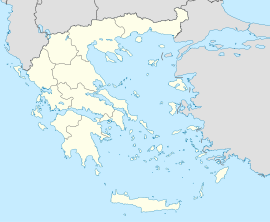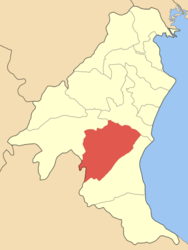- Dion, Pieria
-
Dio
ΔίοLocation Coordinates 40°10′N 22°29′E / 40.167°N 22.483°ECoordinates: 40°10′N 22°29′E / 40.167°N 22.483°E Government Country: Greece Region: Central Macedonia Regional unit: Pieria Municipality: Dio-Olympos Population statistics (as of 2001) Municipal unit - Population: 10,885 Other Time zone: EET/EEST (UTC+2/3) Elevation (center): 129 m (423 ft) Postal: 601 00 Telephone: 23510 Auto: KN Dion or Dium (Ancient Greek: Δίον, Greek: Δίο) is a village and a former municipality in the Pieria peripheral unit, Greece. Since the 2011 local government reform it is part of the municipality Dio-Olympos, of which it is a municipal unit.[1] It is best known for its archaeological site and archaeological museum. Zeus was honored at the ancient city of Dion located at the foot of Mount Olympus. It is located 15 km. SW of Katerini, 425 km to the north of Athens and 65 km to the north of Larissa.
Contents
History
 Ancient Dion is an important archeological site of Macedonian culture.
Ancient Dion is an important archeological site of Macedonian culture.
The village owes its name to the important sanctuary dedicated to Zeus (Dias, "of Zeus"), leader of the gods who dwelt on Mount Olympus; as recorded by Hesiod's Catalogue of Women, Thyia, daughter of Deucalion, bore Zeus two sons, Magnes and Makednos, eponym of Macedonians, who dwelt here in Pieria at the foot of Mount Olympus.[2] The ruins of the ancient city lie within the modern city's boundaries.
The first mention of Dion in history comes from Thucydides, who reports that it was the first city reached by the Spartan general Brasidas after crossing from Thessaly into Macedon on his way through the realm of his ally Perdiccas II during his expedition against the Athenian colonies of Thrace in 424 BC. According to Diodorus Siculus, it was Archelaus I who, at the end of the 5th century BC, gave the city and its sanctuary their subsequent importance by instituting a nine-day festival that included athletic and dramatic competitions in honor of Zeus and the Muses.
Modern times
In modern times, Dion used to be a village called Malathria. In October 1992, it became a municipality, and the municipality now encompasses several villages including Kondariotissa, Vrondou, Karitsa, and Dion. The municipality is called "Dimos Diou" or the "Municipality of Dion", and the administrative center is in the village of Kondariotissa.
Archaeology
The site of ancient Dion was first identified by the English traveler William Martin Leake on December 2, 1806, in the ruins adjoining the village of Malathria. He published his discovery in the third volume of his Travels in Northern Greece in 1835. Léon Heuzey visited the site during his famous Macedonian archaeological mission of 1855 and again in 1861. Later, the epigraphist G. Oikonomos published the first series of inscriptions. Nevertheless, systematic archaeological exploration did not begin until 1928. From then until 1931, G. Sotiriadis carried out a series of surveys, uncovering a 4th-century BC Macedonian tomb and an early Christian basilica. Excavations were not resumed until 1960 under the direction of G. Bakalakis in the area of the theatre and the wall. Since 1973, Professor D. Pandermalis of the Aristotle University of Thessaloniki has conducted archaeological research in the city.
Dion is the site of a large temple dedicated to Zeus, as well as a series of temples to Demeter and to Isis (the Egyptian goddess was a favorite of Alexander). Alexander assembled his armies in Dion before beginning his westward wars of conquest.
In 2006, a statue of Hera was found built into the walls of the city. The statue, 2200 years old, had been used by the early Christians of Dion as filling for the city's defensive wall.[3]
Other
Dion has a school, lyceum, gymnasia, a post office, and squares (plateies).
Historical population
Year Town population Municipality population 1981 1,236 - 1991 1,149 9,876 2001 1,314 10,885 References
- F. Papazoglou, Les villes de Macédoine romaine, Supplément 18 du BCH, Paris, 1988.
- D. Pandermalis, Dion, the archaeological site and the museum, Athens, 1997.
- ^ Kallikratis law Greece Ministry of Interior (Greek)
- ^ Hesiod, Catalogue of Women fr. 7.
- ^ Kantouris, Costas. Greek archaeologists find Hera statue. Associated Press. March 1, 2007.
External links
- Municipality of Dion website
- Official website of the archaeological park of Dion
- Archaeological site of Dion
- Images from the archaelogical site
See also
- Archaeological Museum of Dion
- Communities of Pieria
Greek Macedonia People Greek Macedonians · List of Greek Macedonians
History Ancient Macedonia · List of kings of Macedon · Philip II · Alexander the Great · Wars of the Diadochi · Macedonian Wars · Roman province of Macedonia · Diocese of Macedonia · Theme of Thessalonica · Theme of Strymon · Kingdom of Thessalonica · Ottoman Greece · Greek War of Independence · Greek Struggle for Macedonia · Balkan Wars · Macedonia naming disputeMajor cities Administration Monuments Vergina · Philippi · Dion · Pella · Amphipolis · Paleochristian and Byzantine Monuments of Thessalonika · Mount AthosSymbols Municipality of Dio-Olympos Regional unit of Dio• Agios Spyridonas • Dion (Platanakia) • Karitsa • Kondariotissa • Nea Efesos • VrondouRegional unit of East Olympos• Agios Dimitrios • Ano Skotina • Beach of Panteleimon • Beach of Skotina • Leptokarya • Neoi Poroi • Neos Panteleimonas • Paleoi Poroi • Palios Panteleimonas • Platamon • SkotinaRegional unit of LitochoroMonuments and Museums• Platamon Castle • Museum of Dion • OlympusPieria (peripheral unit)Categories:- Ancient Greek cities
- Populated places in Pieria
- Geography of ancient Pieria
- Culture of Macedon
- Archaeological sites in Macedonia (Greece)
- Argead colonies in Macedonia
- Archelaus I of Macedon
Wikimedia Foundation. 2010.



